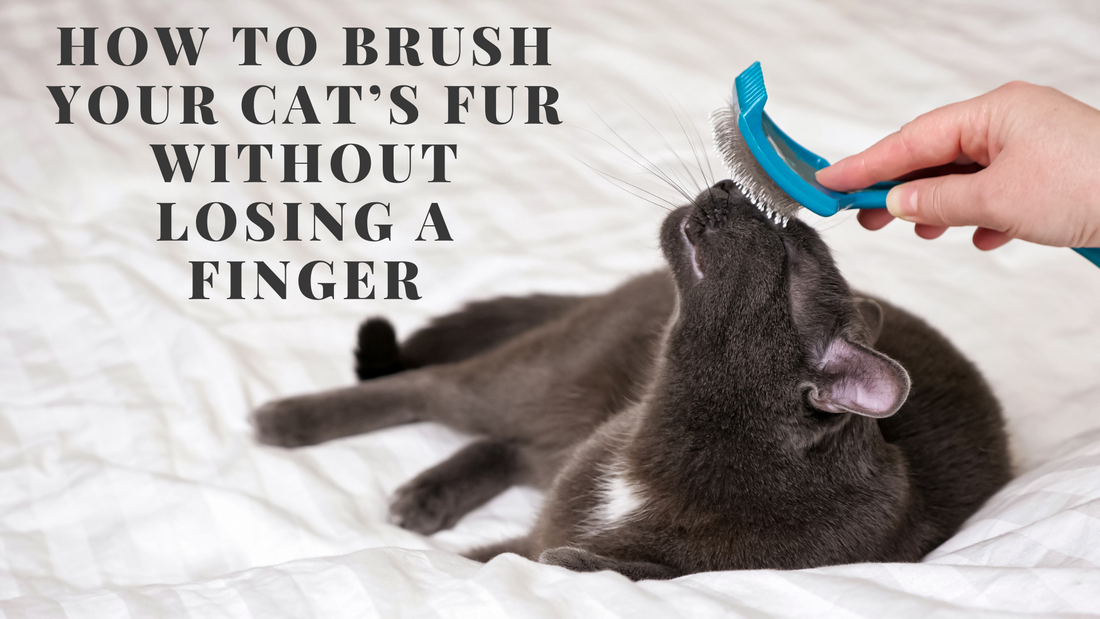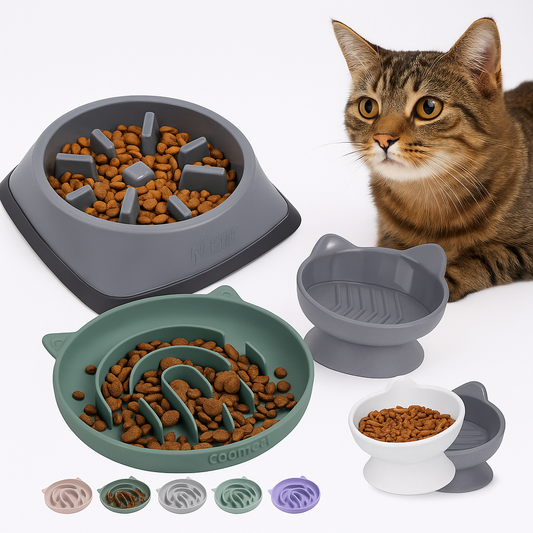
How to Brush Your Cat’s Fur Without Losing a Finger
Why Brushing Your Cat Is Essential for Health & Bonding
Brushing your cat isn't just about aesthetics; it's a vital part of their health and well-being. Regular grooming helps prevent matting, reduces hairballs, and allows you to check for any skin issues or parasites. Moreover, it strengthens the bond between you and your feline friend, turning grooming sessions into quality time.
Benefits of Regular Brushing
- Reduces Shedding: Regular brushing removes loose fur, minimizing the amount of hair your cat sheds around the house.
- Prevents Hairballs: By removing excess hair, you reduce the likelihood of your cat ingesting it during self-grooming, thus preventing hairballs.
- Promotes Healthy Skin and Coat: Brushing stimulates the skin and distributes natural oils, keeping the coat shiny and healthy.
- Early Detection of Health Issues: Regular grooming allows you to spot any abnormalities like lumps, bumps, or parasites early on.
Risks of Skipping Grooming
Neglecting regular brushing can lead to painful matting, especially in long-haired breeds. Mats can cause skin irritation, restrict movement, and even lead to infections. Additionally, excessive shedding can result in more hairballs, which may cause digestive issues.
Source: Complete Cat Guide
Understanding Your Cat’s Temperament Before Brushing

Every cat has a unique personality, and understanding their temperament is crucial before initiating grooming sessions.
If you need a refresher on what your cat’s ears, tails, and posture are telling you, check out our guide on cat body language here.
Recognizing Signs of Stress and Aggression
Cats communicate their discomfort through body language. Be on the lookout for:
- Flattened Ears: Indicates fear or aggression.
- Swishing Tail: A sign of irritation.
- Dilated Pupils: Can indicate fear or excitement.
- Growling or Hissing: Clear signs your cat is not enjoying the experience.
Choose a time when your cat is relaxed, such as after a meal or during their usual resting periods. Avoid initiating grooming when your cat is playful or agitated.
How to Brush a Cat: Step-by-Step Guide
Choosing the Right Brush for Your Cat’s Coat Type
- Short-Haired Cats: Use a soft-bristle brush or grooming glove to remove loose hair and stimulate the skin.
- Long-Haired Cats: Opt for a wide-toothed comb or slicker brush to detangle and prevent mats.
How to Position Your Cat Comfortably
Place your cat on a non-slip surface, like a towel on your lap or a table. Ensure the environment is quiet and free from distractions. Allow your cat to sniff and get accustomed to the brush before starting.
How to Start Brushing Without Triggering Aggression
Begin by gently petting your cat, then slowly introduce the brush, starting with short strokes in areas they enjoy being touched, like the back or behind the ears. Gradually increase the brushing duration as your cat becomes more comfortable.
Brushing Long-Haired Cats Without Stress
Detangling Mats Gently
Hold the base of the mat close to the skin to avoid pulling, and gently work through the tangle with a wide-toothed comb. For stubborn mats, consider using a detangling spray or consult a professional groomer.
Preventing Future Tangles
Regular brushing, at least once a day, is key to preventing mats in long-haired cats. Pay special attention to areas prone to tangling, such as behind the ears, under the legs, and around the neck.
Grooming Aggressive Cats: Practical Techniques

Using Positive Reinforcement During Brushing
Reward your cat with treats and praise during and after grooming sessions to create a positive association. Start with short sessions and gradually increase the duration as your cat becomes more tolerant.
When to Use Protective Gear
If your cat is prone to scratching or biting, consider using protective gloves or a grooming bag to ensure safety for both you and your pet.
When to Seek Professional Grooming Help
If your cat becomes highly aggressive or stressed during grooming, it's advisable to seek assistance from a professional groomer or veterinarian who can handle the situation safely.
How to Groom a Cat That Hates Brushing
Gradual Desensitization Techniques
Introduce the brush slowly, allowing your cat to sniff and explore it. Start with brief brushing sessions in areas your cat enjoys being touched, gradually increasing the duration over time.
Using Treats and Breaks Effectively
Incorporate treats during and after brushing to reward your cat's cooperation. If your cat becomes agitated, take a break and resume later to prevent negative associations.
Common Mistakes to Avoid When Brushing Your Cat
Brushing Too Hard or Fast
Applying excessive pressure or brushing too quickly can cause discomfort or pain, leading to negative associations with grooming. Always use gentle, slow strokes.
Forcing Your Cat to Stay Still
Restraint can increase stress and aggression. Allow your cat to move freely, and keep sessions short to maintain a positive experience.
Essential Tools for Stress-Free Cat Grooming
Grooming doesn’t need a drawer full of gadgets, but the right tools can transform the brushing experience from a stressful battle into a calm, bonding moment.
Upgrade Your Grooming Kit with These Tools
Having the right tools on hand can transform grooming from a stressful standoff into a calm bonding ritual that benefits both you and your cat. We’ve tested countless brushes and combs ourselves, and if you’re dealing with long-haired cats, you can also check out our detailed review of top grooming tools here.
- Grooming Mitts: Great for cats who dislike traditional brushes, these mitts let you pet while gently removing loose fur, making brushing feel like cuddle time.
- Slicker Brushes with Flexible Pins: Ideal for long-haired cats prone to tangles, these brushes glide through the coat, tackling knots without harsh pulling.
- Fine-Toothed Flea Combs: Perfect for finishing touches, they help catch stray hairs and spot fleas early.
- Undercoat Rakes: Useful during heavy shedding seasons, especially for medium to long-haired cats, to remove the loose undercoat without damaging top fur.
- Soft Silicone Brushes: Suitable for cats with sensitive skin, these are gentle yet effective for removing loose hair.
Helpful Add-Ons for Easier Grooming
- Detangling Sprays: Look for cat-safe, leave-in detanglers to help work through knots gently, reducing tugging.
- Calming Pheromone Sprays: Products like Feliway can help soothe anxious cats before brushing sessions, making the environment more relaxed.
- Cat Treats: Technically not a tool, but vital! Use treats to reward your cat during grooming, helping create a positive association.
When to Brush Your Cat and How Often

Brushing Frequency by Coat Type
- Short-Haired Cats: Once or twice a week.
- Long-Haired Cats: Daily brushing is recommended to prevent matting.
Seasonal Considerations
During shedding seasons (spring and fall), increase brushing frequency to manage excess hair and reduce hairballs.
FAQs on How to Brush a Cat Without Losing a Finger
How Do I Brush a Cat That Bites?
Use positive reinforcement with treats and keep sessions short. If necessary, use protective gloves and consult a professional for guidance.
Can I Sedate My Cat for Grooming?
Sedation should only be considered under veterinary supervision, typically for severe cases where grooming is essential for the cat's health.
How Do I Keep My Cat Calm During Brushing?
Create a calm environment, use gentle strokes, and incorporate treats to make the experience positive. Regular, short sessions can help your cat become accustomed to grooming.
What Brush Works Best for Aggressive Cats?
Grooming gloves or soft-bristle brushes are less intimidating and can be more acceptable to sensitive or aggressive cats.
How Do I Remove Mats Without Hurting My Cat?
Hold the base of the mat to avoid pulling the skin, and gently work through the tangle with a wide-toothed comb or dematting tool. For severe mats, consult a professional groomer.
Is Professional Grooming Worth It for Aggressive Cats?
Yes, professional groomers have the experience and tools to handle aggressive cats safely, ensuring their coat is maintained without causing stress or injury.
Conclusion: Building Trust While Keeping Your Cat’s Coat Healthy
Brushing your cat doesn't have to be a battle. With patience, the right tools, and a gentle approach, grooming can become a bonding experience that benefits both you and your feline companion. Remember, every cat is different, so tailor your grooming routine to suit your cat's individual needs and preferences.



